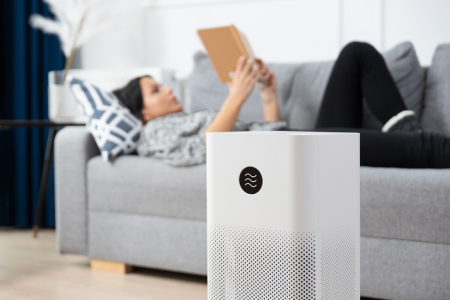Boosting Indoor Air Quality During Cooler Months
Tuesday, Oct 14, 2025
Boosting Indoor Air Quality During Cooler Months
When the days grow shorter and the temperatures dip, many of us begin to spend more time indoors. Windows stay shut, heaters kick on, and the air in our homes can quickly become stale. While cozying up inside feels comforting, indoor air quality often suffers during the cooler months. Dust, allergens, and even toxins can accumulate in sealed spaces, affecting everything from our comfort to our long-term health.
The good news? With a few smart choices—like bringing in the right plants, using purifiers, and practicing healthy daily habits—you can keep your indoor air clean and fresh all season long.
Why Indoor Air Quality Matters in the Fall and Winter
Indoor air can be up to five times more polluted than outdoor air. When we keep windows and doors closed to conserve heat, pollutants have fewer ways to escape. Common culprits include:
- Dust and pet dander
- Mold spores from damp areas
- Chemicals from cleaning products or furniture
- Carbon monoxide or smoke from fireplaces and gas stoves
Poor indoor air quality can cause issues like dry throat, fatigue, and congestion. For those with asthma or allergies, the effects can be even more noticeable. Thankfully, creating a healthier home environment doesn’t have to be complicated.
Harnessing the Power of Houseplants
Nature has a way of helping us breathe easier—literally. While plants won’t solve all indoor air quality issues, many can help filter toxins and improve humidity levels. Plus, they add beauty and life to your space during the darker months.
Top picks for air-purifying plants:
- Snake Plant (Sansevieria): Known for being nearly indestructible, snake plants filter toxins like formaldehyde and benzene. They also release oxygen at night, making them perfect for bedrooms.
- Peace Lily: Not only does it bloom indoors, but it’s also great at reducing mold spores in the air.
- Spider Plant: Pet-friendly and low-maintenance, spider plants absorb carbon monoxide and improve overall air freshness.
- Aloe Vera: Beyond its healing gel, aloe vera helps monitor air quality—brown spots on its leaves can indicate high chemical levels.
- Boston Fern: A natural humidifier, Boston ferns (also known as sword ferns) help restore moisture to dry winter air. It is non-toxic to dogs and cats, making it an excellent indoor option.
Pro Tip: Don’t overwater your plants. Too much moisture can encourage mold growth in the soil, which works against your goal of cleaner air.
Investing in Air Purifiers
While plants make a significant impact, air purifiers are one of the most effective tools for improving indoor air quality. Modern purifiers use filters and technology to capture microscopic particles that would otherwise linger in the air.
What to look for in a purifier:
- HEPA Filters: These capture 99.97% of particles as small as 0.3 microns, including dust, pollen, and pet dander.
- Activated Carbon Filters: Ideal for removing odors and volatile organic compounds (VOCs) from cleaning products or paints.
- Quiet Operation: Especially important for bedrooms or home offices.
- Proper Size: Make sure the purifier’s coverage area matches the size of the room you’ll use it in.
Placing purifiers in high-traffic spaces like living rooms, bedrooms, or home offices ensures that the air you breathe most often is the cleanest.
Habits That Keep Air Fresh
Beyond plants and purifiers, everyday habits play a huge role in maintaining indoor air quality. By being intentional about how you live in your space, you can minimize pollutants and maximize freshness.
1. Keep Filters Clean
Replace or clean HVAC filters every 1–3 months. A clogged filter restricts airflow and recirculates dust into your home.
2. Vacuum and Dust Regularly
Use a vacuum with a HEPA filter to capture fine particles, and don’t forget to dust surfaces where allergens like to settle, like windowsills and fan blades.
3. Control Humidity
Dry winter air can irritate sinuses, while excess humidity encourages mold growth. Aim to keep indoor humidity between 30–50%. A small humidifier in bedrooms or living areas can balance things out. If your home is in an area with high humidity, consider adding dehumidifiers in key spaces.
4. Limit Chemical Use
Choose natural cleaning products or make your own with vinegar and baking soda. Strong chemical cleaners can release VOCs that linger in closed-up homes.
5. Ventilate Smartly
Even in wintry weather, it’s wise to crack open a window for a few minutes each day to let stale air out and fresh air in. Cooking? Use your range hood or open a nearby window to clear out smoke and odors.
6. Be Mindful of Fireplaces and Candles
Wood-burning fireplaces and scented candles may create cozy ambiance, but they also release smoke and particles. Use them sparingly or opt for soy candles and gas fireplaces when possible.
7. Remove Shoes at the Door
Shoes track in dirt, pesticides, and allergens from outside. A simple shoe-free policy can cut down on indoor pollutants dramatically.
Small Changes, Big Impact
Improving your indoor air quality during cooler months doesn’t require an overhaul of your home—it’s about small, consistent actions. Adding a few plants, using a reliable air purifier, and practicing mindful cleaning habits can make a noticeable difference in how your space feels.
When the air inside your home is fresh and clean, you’ll not only breathe easier but also feel more energized and comfortable throughout the winter season.
Final Thoughts
As we spend more time indoors during fall and winter, air quality should be a top priority for everyone. Plants, purifiers, and smart habits all work together to create a healthier environment. The result? A home that feels just as refreshing as the crisp autumn air outside—without the chill. Start small—try adding one plant to your living room, cleaning your HVAC filter, or running an air purifier in your bedroom. Over time, these simple steps add up to a fresher, healthier home.

